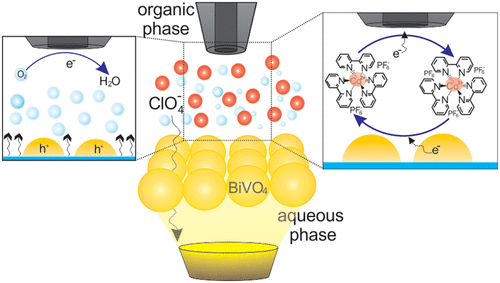当前位置:
X-MOL 学术
›
J. Phys. Chem. C
›
论文详情
Our official English website, www.x-mol.net, welcomes your
feedback! (Note: you will need to create a separate account there.)
Characterization of Photoactivity of Nanostructured BiVO4 at Polarized Liquid–Liquid Interfaces by Scanning Electrochemical Microscopy
The Journal of Physical Chemistry C ( IF 3.3 ) Pub Date : 2017-11-14 00:00:00 , DOI: 10.1021/acs.jpcc.7b09550 Shokoufeh Rastgar 1 , Gunther Wittstock 1
The Journal of Physical Chemistry C ( IF 3.3 ) Pub Date : 2017-11-14 00:00:00 , DOI: 10.1021/acs.jpcc.7b09550 Shokoufeh Rastgar 1 , Gunther Wittstock 1
Affiliation

|
Scanning electrochemical microscopy (SECM) has been used for recording the photoinduced charge-transfer reactions at bismuth vanadate (BiVO4) photocatalyst nanostructures arranged at chemically polarized liquid/liquid (L/L) interfaces between an organic butyronitrile electrolyte and an aqueous electrolyte containing perchlorate as common anion. In addition, [Co(bpy)3](PF6)3 soluble in the organic phase was used as a probe of SECM analysis but also as a sacrificial agent, which effectively improves the separation efficiency of photogenerated charge carriers at the BiVO4 modified L/L interface. The nanoassembled layer did not require contact to a current collector. Interfacial polarization effects on the photoinduced charge-transfer reactions have been investigated by recording the regeneration of the reduced form [Co(bpy)3](PF6)2 at the BiVO4 particle layer in organic phase in SECM feedback approach curves. The kinetic parameters of the interfacial photoinduced electron transfer (ET) reaction have been analyzed under chemically controllable galvanic potential difference at the L/L interface. The potential dependence of the photoinduced ET rate constants followed Butler–Volmer theory. The photogenerated oxygen species distribute between the aqueous and organic phases through the porous BiVO4 particle layer. It can be traced by a transient current for O2 reduction at a gold microelectrode positioned close to the particle layer in the organic phase and biased for diffused-controlled O2 reduction. The results represented a new approach to characterize semiconductor photocatalyst systems spontaneously assembled at the L/L interface and their use for water oxidation reaction as a challenging step in overall water splitting process.
中文翻译:

扫描电化学显微镜表征在极化液-液界面上的纳米结构BiVO 4的光活性
扫描电化学显微镜(SECM)已用于记录钒酸铋(BiVO 4)光催化剂纳米结构的光诱导电荷转移反应,该结构布置在有机丁腈电解质和含高氯酸盐的水性电解质之间的化学极化液/液(L / L)界面处作为常见的阴离子。另外,可溶于有机相的[Co(bpy)3 ](PF 6)3用作SECM分析的探针,但也用作牺牲剂,可有效提高BiVO 4处光生载流子的分离效率。修改的L / L接口。纳米组装层不需要与集电器接触。通过在SECM反馈方法曲线中记录BiVO 4颗粒层在有机相中还原形式[Co(bpy)3 ](PF 6)2的再生,研究了界面极化对光诱导的电荷转移反应的影响。在L / L界面的化学可控电势差下,分析了界面光诱导电子转移(ET)反应的动力学参数。光诱导的ET速率常数的潜在依赖性遵循Butler-Volmer理论。光生氧通过多孔BiVO在水相和有机相之间分布4个粒子层。它可以通过瞬态电流追踪,该瞬态电流用于在有机相中靠近颗粒层的金微电极上还原O 2,并偏置以进行扩散控制的O 2还原。结果代表了表征在L / L界面自发组装的半导体光催化剂系统的一种新方法,以及将其用于水氧化反应的过程,这是整个水分解过程中的一个挑战性步骤。
更新日期:2017-11-15
中文翻译:

扫描电化学显微镜表征在极化液-液界面上的纳米结构BiVO 4的光活性
扫描电化学显微镜(SECM)已用于记录钒酸铋(BiVO 4)光催化剂纳米结构的光诱导电荷转移反应,该结构布置在有机丁腈电解质和含高氯酸盐的水性电解质之间的化学极化液/液(L / L)界面处作为常见的阴离子。另外,可溶于有机相的[Co(bpy)3 ](PF 6)3用作SECM分析的探针,但也用作牺牲剂,可有效提高BiVO 4处光生载流子的分离效率。修改的L / L接口。纳米组装层不需要与集电器接触。通过在SECM反馈方法曲线中记录BiVO 4颗粒层在有机相中还原形式[Co(bpy)3 ](PF 6)2的再生,研究了界面极化对光诱导的电荷转移反应的影响。在L / L界面的化学可控电势差下,分析了界面光诱导电子转移(ET)反应的动力学参数。光诱导的ET速率常数的潜在依赖性遵循Butler-Volmer理论。光生氧通过多孔BiVO在水相和有机相之间分布4个粒子层。它可以通过瞬态电流追踪,该瞬态电流用于在有机相中靠近颗粒层的金微电极上还原O 2,并偏置以进行扩散控制的O 2还原。结果代表了表征在L / L界面自发组装的半导体光催化剂系统的一种新方法,以及将其用于水氧化反应的过程,这是整个水分解过程中的一个挑战性步骤。









































 京公网安备 11010802027423号
京公网安备 11010802027423号